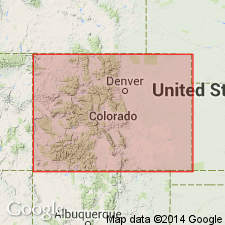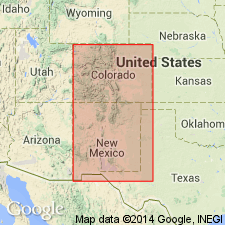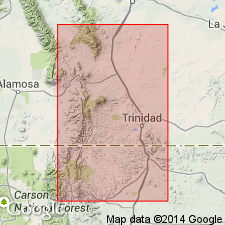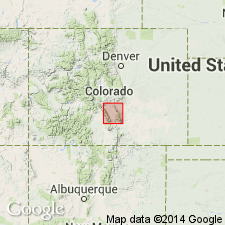
- Usage in publication:
-
- Huerfano beds*
- Modifications:
-
- First used
- Dominant lithology:
-
- Sandstone
- Conglomerate
- Marl
- Clay
- AAPG geologic province:
-
- Las Vegas-Raton basin
Summary:
First published use as Huerfano beds [but stratigraphic extent or boundaries of Huerfano not clearly stated.] These beds may have been intended by author to be limited to the lower division 3,500 to 4,500 ft thick measured down Poison Canyon and across Muddy Creek to Promontory Bluffs, Huerfano Co, CO in the Las Vegas-Raton basin. Unconformably overlies Laramie [formation] and Colorado [formation]. Underlies the middle division of the Poison Canyon "series." The lower division consists of yellowish sandstone and conglomerate with yellow clay or marl beds occasionally. Assigned to the early Tertiary, Eocene. Sketch map shows location of rocks of Eocene age. No type locality designated.
Source: GNU records (USGS DDS-6; Denver GNULEX).

- Usage in publication:
-
- Huerfano beds
- Modifications:
-
- Revised
- AAPG geologic province:
-
- Las Vegas-Raton basin
Summary:
Name restricted to the upper division of the section measured on Muddy Creek, Huerfano Co, CO in the Las Vegas-Raton basin. The upper division consists of red and yellow sandy clay, marl, and some white, gray, and green sand 2,000 ft thick. The upper division overlies the middle division which is assigned to the Poison Canyon beds. The mistaken identification was due to mistake by the author in his original notes. Of Eocene age.
Source: GNU records (USGS DDS-6; Denver GNULEX).

- Usage in publication:
-
- Huerfano formation*
- Modifications:
-
- Revised
- AAPG geologic province:
-
- Las Vegas-Raton basin
Summary:
Beds of buff conglomeratic sandstone that have been included in upper part of the Huerfano are removed from it and assigned to a younger unit, Farisita conglomerate (a new name) in the Las Vegas-Raton basin. As restricted, Huerfano is a unit of variegated shale with zones of red, white, and tan sandstone. Is known principally in Huerfano Park where it may be 0 to 2,000 ft thick, unconformably overlying Cuchara formation and unconformably underlying Farisita. Outliers known on West Spanish Peak. Deposited on floodplains and bordering lowlands in middle Eocene time.
Source: GNU records (USGS DDS-6; Denver GNULEX).

- Usage in publication:
-
- Huerfano Formation*
- Modifications:
-
- Overview
- AAPG geologic province:
-
- Las Vegas-Raton basin
Summary:
Name applied to red sandstone and mudstone derived chiefly from Permian and Pennsylvanian red beds in the Sangre de Cristo Range. Thought to be the lateral equivalent of the Farisita Conglomerate (yellowish-gray coarse conglomerate and sandstone derived from granitic rocks in the Wet Mountains) and of the Cuchara Formation (a mixture of Huerfano and Farisita lithologies). These three lithologies would be best considered a facies of one formation, rather than three individual formations. Mapped with Huerfano and Farisita in Huerfano Park, Huerfano Co, CO in Las Vegas-Raton basin. Assigned an Eocene age.
Source: GNU records (USGS DDS-6; Denver GNULEX).
For more information, please contact Nancy Stamm, Geologic Names Committee Secretary.
Asterisk (*) indicates published by U.S. Geological Survey authors.
"No current usage" (†) implies that a name has been abandoned or has fallen into disuse. Former usage and, if known, replacement name given in parentheses ( ).
Slash (/) indicates name conflicts with nomenclatural guidelines (CSN, 1933; ACSN, 1961, 1970; NACSN, 1983, 2005, 2021). May be explained within brackets ([ ]).

